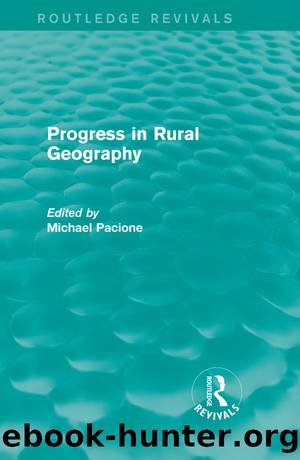Progress in Rural Geography (Routledge Revivals) by Michael Pacione

Author:Michael Pacione [Pacione, Michael]
Language: eng
Format: epub
ISBN: 9780415707602
Barnesnoble:
Publisher: Taylor & Francis
Published: 2014-12-04T00:00:00+00:00
The Dynamics of Change
Significant changes have taken place in rural areas with respect to the population, the distribution of facilities and the transport links. It is difficult to generalise, but an attempt will be made to highlight certain key issues which have a special relevance to transport provision and accessibility. The first dimension of change is the social one. From the 1981 census, there is some evidence of population growth in urban fringe areas, particularly in the southern part of Britain (see Chapter 4). Additionally, many upland areas have reversed the population declines of the 1960s (Randolph and Robert, 1981). However, the overall changes conceal the selective nature of the movers out of rural areas and the movers back into rural areas. The net result is that one is not left with a balanced profile of the total population but people with different life-styles and aspirations. There is the old established resident who may be elderly (about 25 per cent of the population in the remote rural areas are elderly, as compared with a national average of 17 per cent) and who has had to accommodate to declining levels of service; on the other hand there is the recent migrant who may have urban-based life-styles and only resides in the rural area but plays no active part in the rural community. In effect, one has communities within communities (Pahl, 1964).
The one persistent feature with respect to the provision of facilities has been the trend towards concentration into fewer, larger units. These units, particularly shops, are usually located in the urban centres and not locally, with the result that the distances to be travelled will be increased. There is also some evidence of school closure in rural areas, particularly in the primary school sector where a minimum of 50â60 pupils was considered by the Plowden Report (G.B., Department of Education, 1967) to be a âviableâ unit. Health-care facilities have become characterised by group practices with large catchment areas and hospital facilities have become both more centralised and specialised (Rigby, 1977). However, there is evidence to suggest that a reversal is now taking place with the growth of community hospital facilities. Many of these changes have taken place without a thorough consideration of the additional transport costs involved. Concentration has also resulted in the closure of local facilities, including shops, post offices and petrol stations (Association of County Councils, 1979; Taylor and Emerson, 1981). Petrol prices are typically about 15 per cent higher in rural areas and oil companies have been pursuing a policy of closure for small rural petrol stations; Shell and Esso closed 2,000 rural petrol stations in 1980 (Motor Agents Association, 1981). All these changes have resulted in a decline in the levels of local accessibility with an increase in the requirements for transport.
Table 6.1: Journey Lengths in Rural Areas â By Stage in Kilometres Purpose Rurala areas Mean for all areas % difference
Work 7.91 5.75 + 36
Education 4.10 2.56 + 60
Shopping 6.24 3.44 + 81
Social 9.95 7.40 + 34
Escort 7.
Download
This site does not store any files on its server. We only index and link to content provided by other sites. Please contact the content providers to delete copyright contents if any and email us, we'll remove relevant links or contents immediately.
Adding Value to Policy Analysis and Advice by Claudia Scott; Karen Baehler(456)
Sociological Perspectives of Health and Illness by Constantinos N. Phellas(445)
Race and American Political Development by unknow(441)
American Government and Politics Today by Steffen W. Schmidt Mack C. Shelley Barbara A. Bardes(427)
Human and Global Security : An Exploration of Terms by Peter Stoett(425)
Control Of Oil - Hardback by Kayal(407)
Entrepreneurship Education and Training: The Issue of Effectiveness by Colette Henry Frances Hill Claire Leitch(368)
The Catholic Church and European State Formation, AD 1000-1500 by Jørgen Møller(356)
Materializing the Middle Passage by Jane Webster;(351)
The World According to China by Elizabeth C. Economy(344)
Left Is Not Woke by Susan Neiman(328)
Turkey's Relations with the West and the Turkic Republics: The Rise and Fall of the Turkish Model by Idris Bal(313)
Theories of Counseling and Psychotherapy: A Case Approach by Nancy L. Murdock(313)
Cross-Cultural Child Development for Social Workers by Lena Robinson(307)
Japan's Ainu Minority in Tokyo by Mark K. Watson(297)
Advances in Child Development and Behavior, Volume 37 by Patricia J. Bauer(295)
Laboratory Life by Bruno Latour(294)
Beyond Service: State Workers, Public Policy, and the Prospects for Democratic Administration by Greg McElligott(285)
The Oxford Handbook of Museum Archaeology by Stevenson Alice;(275)
